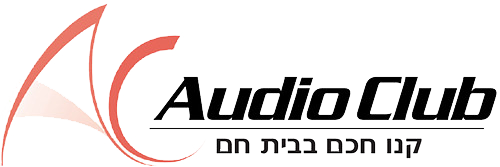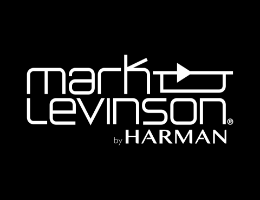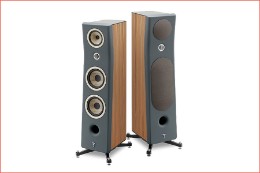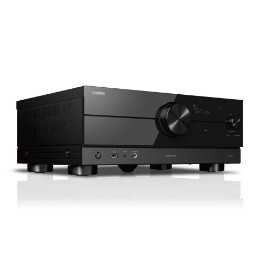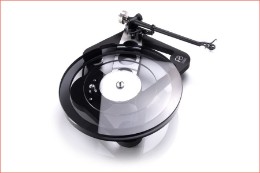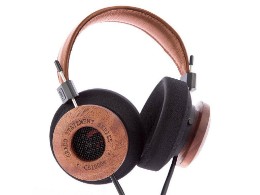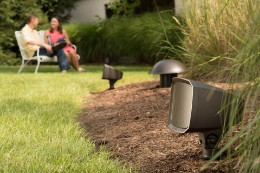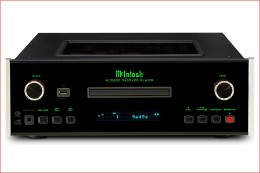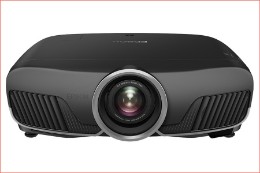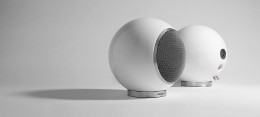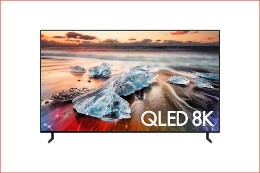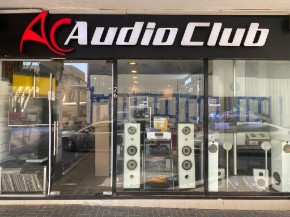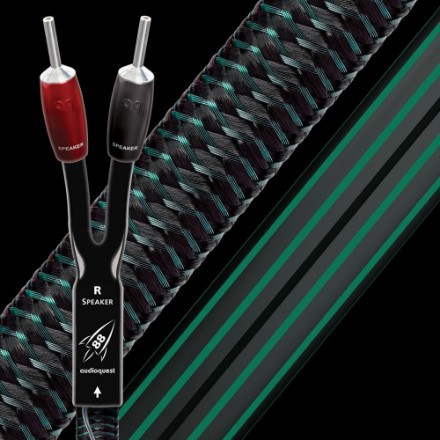Audioquest
Rocket 88 incorporates AudioQuest's patented Dielectric-Bias System (DBS) and replaces Long-Grain Copper with solid Perfect-Surface Copper+. DBS offers a lower noise-floor, so you can hear deeper into the nuances of your favorite music. At the same time the addition of more PSC+ offers a smoother, more relaxed, and natural sonic timbre and texture.
7,395 ₪
Rocket 44 incorporates Perfect-Surface Copper+ into its blend of conductors. PSC+ has fewer grain boundaries, which reduces harshness in the sound. This carefully finessed combination of PSC and PSC+ enables Rocket 44 to deliver a clear and faithful presentation.
3,990 ₪
This Double Star-Quad Geometry "Rocket" cable does not look normal on the outside, and it is not at all normal on the inside. A sophisticated combination of extraordinary materials and extremely refined design allows the Rockets to honor all types of music equally.
3,145 ₪
A clearly audible step up from Rocket 11, Rocket 22 is an ideal Full-Range or Single-BiWire cable. Single-BiWire allows you to optimize performance when the speakers have Bass and Treble inputs. BiWiring reduces distortion in the cable — taking the big Bass energy out of the cable carrying the more delicate Treble is like taking the waves out of the water when you (the Treble) are trying to swim. The magnetic autonomy of the separate halves of the Rocket 22 maximizes the BiWire advantage. Semi-Solid Concentric conductors are a far-superior performance alternative to typical stranded conductors. Semi-Solid Concentric conductors use fewer, larger strands that do not change position down the length of the cable. The strands maintain their fixed, rigid relationships, reducing distortion, improving resolution and dynamics, and greatly minimizing harshness and confusion due to strand interaction. Perfect-Surface Copper/Long-Grain Copper: LGC has fewer oxides within the conducting material, fewer impurities and fewer grain boundaries than standard OFHC copper. LGC s used for the Rocket 22’s conductors located within the central area of the Semi-Solid Concentric Conductor bundle. PSC, with its astonishingly smooth surface, is used for the outer-layer of conductors in Rocket 22’s Semi-Solid Concentric Conductor bundle. It is this outer layer of conductors that have the most effect on Rocket 22’s clarity and smoothness. Careful application of PSC and LGC enables performance closer to using only the more expensive PSC, while gaining the economic advantage of the superb LGC. Double Low-Inductance Geometry: A “normal” speaker cable has fairly high-inductance, smearing energy across time and making the sound dull and unfocused. The two conductors in each half of Rocket 22 provide lower inductance, greater clarity and superior bass-to-treble frequency extension. Rocket 22 is prepared with SureGrip 300 spades or bananas. These connectors feature Direct-Silver over copper with no layer of nickel in between.
2,495 ₪
Rocket 11 is an ideal Full-Range or Single-BiWire cable. Single-BiWire allows you to optimize performance when the speakers have Bass and Treble inputs. BiWiring reduces distortion in the cable — taking the big Bass energy out of the cable carrying the more delicate Treble is like taking the waves out of thewater when you (the Treble) are trying to swim. The magnetic autonomy of the separate halves of the Rocket 11 maximizes the BiWire advantage. Semi-Solid Concentric conductors are a far-superior performance alternative to typical stranded conductors. Semi-Solid Concentric conductors use fewer, larger strands that do not change position down the length of the cable. The strands maintaintheir fixed, rigid relationships, reducing distortion, improving resolution and dynamics, and greatly minimizing harshness and confusion due to strand interaction. Long-Grain Copper has fewer oxides within the conducting material, fewer impurities, fewer grain boundaries and definitively better performance than standard OFHC copper. Double Low-Inductance Geometry: A “normal” speaker cable has fairly high-inductance, smearing energy across time and making the sound dull and unfocused. The two conductors in each half of Rocket 11 provide lower inductance, greater clarity and superior bass-to-treble frequency extension. Rocket 11 is prepared with SureGrip 300 spades or bananas. These connectors feature Direct-Silver over copper with no layer of nickel in between.
1,345 ₪
The speaker cable model Type 4 was first introduced about 1983. It wasn’t the prettiest cable, but the performance advantage of its polypropylene insulation was dramatic and much appreciated. Several evolutionary steps later, the current version of Type 4 was introduced in 1995—a design whose foundation is so well balanced that it hasn’t changed since then—and still isn’t changing. Types 9+DBS Low-Distortion & Low-Noise speaker cable is essentially Type 4 with better metal, added layers and techniques of Noise-Dissipation for more effective noise control and AQ's patented Dialectric-Bias System (DBS) In addition, Type-9+DBS conductors are a little bigger than previous 4-series cables. The conductors are a little farther apart, reducing interaction between adjacent conductors by 35%. Solid Perfect-Surface+ Sonic-Signature Conductors Multi-Layer Carbon-Based Noise-Dissipation and Direction-Controlled Conductors 72V Dielectric-Bias System with Carbon Level Radio-Frequenecy Trap Star-Quad Geometry
4,495 ₪
The speaker cable model Type 4 was first introduced about 1983. It wasn’t the prettiest cable, but the performance advantage of its polypropylene insulation was dramatic and much appreciated. Several evolutionary steps later, the current version of Type 4 was introduced in 1995—a design whose foundation is so well balanced that it hasn’t changed since then—and still isn’t changing. Types 9 Low-Distortion & Low-Noise speaker cable is essentially Type 4 with better metal, and with added layers and techniques of Noise-Dissipation for more effective noise control than any previous Type 4 iteration. In addition, Type-9 conductors are a little bigger than previous 4-series cables. The conductors are a little farther apart, reducing interaction between adjacent conductors by 35%. Solid Perfect-Surface+ Sonic-Signature Conductors Multi-Layer Carbon-Based Noise-Dissipation and Direction-Controlled Conductors Star-Quad Geometry
2,995 ₪
The speaker cable model Type 4 was first introduced about 1983. It wasn’t the prettiest cable, but the performance advantage of its polypropylene insulation was dramatic and much appreciated. Several evolutionary steps later, the current version of Type 4 was introduced in 1995—a design whose foundation is so well balanced that it hasn’t changed since then—and still isn’t changing. Types 5 Low-Distortion & Low-Noise speaker cable is essentially Type 4 with better metal, and with conductors that are a little farther apart, reducing interaction between adjacent conductors by 35%. Solid Perfect-Surface+ Sonic-Signature Conductors Carbon-Loading and Direction-Controlled Conductors Star-Quad Geometry
1,745 ₪
Can a speaker cable sound great, be practical and easy to use, be sexy and be easily affordable? Yes! Q2's inner Long-Grain Copper (LGC) conductor is surrounded by an outer spiral of 11 strands of LGC. The result is AQ's new flexible Solid+ Concentric Conductor, with sound quality even closer to that of an ideal solid conductor and yet big enough to make a great cable with only two simple-to-prepare conductors. Then, the two conductors (+ and -) are spiraled for minimum inductance (inductance makes sound seem out of focus), and maximum clarity and dynamics...and then this ideal cable is given a sexy, square, deep black outer jacket.
815 ₪
In 1982 Sony gave us "Perfect sound forever," along with the attitude that, "it's just digital, so all CD players sound the same." That was disproved and qualitative differences between players became accepted truth. Next came separate transport and DAC combos, which brought with it the attitude that "all S/PDIF digital audio cables sound the same..." until that too became disproved. Now the frontier has moved once again. Is digital audio really just ones and zeros? We don't believe so, and once you've had a chance to listen to Cinnamon USB, you won't think so either...
445 ₪
In 1982 Sony gave us "Perfect sound forever," along with the attitude that, "it's just digital, so all CD players sound the same." That was disproved and qualitative differences between players became accepted truth. Next came separate transport and DAC combos, which brought with it the attitude that "all S/PDIF digital audio cables sound the same..." until that too became disproved. Now the frontier has moved once again. Is digital audio really just ones and zeros? We don't believe so, and once you've had a chance to listen to Diamond USB, you won't think so either...
3,245 ₪
In 1982 Sony gave us "Perfect sound forever," along with the attitude that, "it's just digital, so all CD players sound the same." That was disproved and qualitative differences between players became accepted truth. Next came separate transport and DAC combos, which brought with it the attitude that "all S/PDIF digital audio cables sound the same..." until that too became disproved. Now the frontier has moved once again. Is digital audio really just ones and zeros? We don't believe so, and once you've had a chance to listen to Coffee USB, you won't think so either...
1,845 ₪
In 1982 Sony gave us "Perfect sound forever," along with the attitude that, "it's just digital, so all CD players sound the same." That was disproved and qualitative differences between players became accepted truth. Next came separate transport and DAC combos, which brought with it the attitude that "all S/PDIF digital audio cables sound the same..." until that too became disproved. Now the frontier has moved once again. Is digital audio really just ones and zeros? We don't believe so, and once you've had a chance to listen to Carbon USB, you won't think so either..
845 ₪
In 1982 Sony gave us "Perfect sound forever," along with the attitude that, "it's just digital, so all CD players sound the same." That was disproved and qualitative differences between players became accepted truth. Next came separate transport and DAC combos, which brought with it the attitude that "all S/PDIF digital audio cables sound the same..." until that too became disproved. Now the frontier has moved once again. Is digital audio really just ones and zeros? We don't believe so, and once you've had a chance to listen to Forest USB, you won't think so either...
325 ₪
For systems that use a TV’s eARC/ARC output as the audio source, AudioQuest’s eARC-Priority models offer world-class performance at the friendliest possible prices. AudioQuest eARC-Priority cables are full-on 48-Series HDMI cables with the 48Gbps bandwidth required for 8K-10K video and all the latest video features. While the main A/V data pairs have Cinnamon-level performance (Forest 48’s solid 0.5% Silver + Carbon & Vodka 48’s Level-3 Noise-Dissipation), the eARC data pair and Ground-Reference drain in eARC-Priority cables use all the same advanced design ingredients as their “48” siblings. Dragon eARC features 100% Perfect-Surface Silver eARC conductors and Ground-Reference conductors with Level-6 Noise Dissipation. For soundbars and other ARC input-equipped gear, this allocation of design and material resources offers a super combination of performance and value.
10,995 ₪
For systems that use a TV’s eARC/ARC output as the audio source, AudioQuest’s eARC-Priority models offer world-class performance at the friendliest possible prices. AudioQuest eARC-Priority cables are full-on 48-Series HDMI cables with the 48Gbps bandwidth required for 8K-10K video and all the latest video features. While the main A/V data pairs have Cinnamon-level performance (Forest 48’s solid 0.5% Silver + Carbon & Vodka 48’s Level-3 Noise-Dissipation), the eARC data pair and Ground-Reference drain in eARC-Priority cables use all the same advanced design ingredients as their “48” siblings. ThunderBird eARC features 10% Silver eARC conductors and Ground-Reference conductors with Level-5 Noise Dissipation. For soundbars and other ARC input-equipped gear, this allocation of design and material resources offers a superb combination of performance and value.
3,245 ₪
